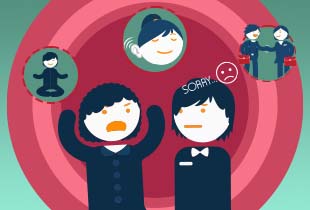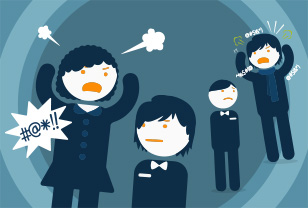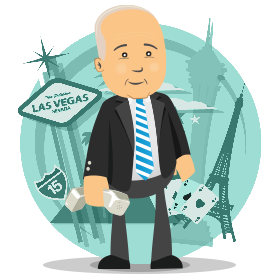Identifying customers
Customer service providers in cartoons have it so easy. They can tell when they’re faced with an angry customer – because the customer turns red! When their customer is disgusted – they go green. And when they’re happy – they glow, nice and golden. Unfortunately for us in the real world, very rarely will a customer be holding a sign indicating what mood they’re in.
Of course, some people wear their heart right on their sleeve but not everyone is as easy to read and if you mistake a disappointed customer for an angry customer or an anxious customer as a difficult customer, it can cost you a lot more than just the sale.
A good businessperson will take into account a customer’s body language, tone of voice and the key words they use to ascertain exactly what kind of a customer they are and consequently how they should be dealt with.
By determining what kind of customer has just materialised in front of you, you’ll be in a better position to capitalise on the opportunity or rectify the problem.
So what sort of customer do you have today?
The Happy Customer
Identifying the happy customer
A happy customer is possibly the easiest type to spot.
- Happy customers will often offer a compliment.
- Happy customers will often tell you exactly what part of the service they loved.
- Happy customers may display an openness to other complementary products/services you offer.
Providing customer service to happy customers
So what do you do? A happy customer is a huge opportunity for you as a customer service provider.
- If offered a compliment, thank them and pass on the positive feedback to colleagues. This will not only boost morale but help identify what’s working for your business.
- Cross- or up-sell them and perhaps increase the value of the sale.
- Ask them for a testimonial or referral to help attract more customers.
The Angry Customer
Identifying the angry customer
An Angry Customer will want to complain. They’ll want to vent some steam at you and your organisation.
- Angry customers can be emotional, aggressive or just visibly upset.
- Angry customers’ language may be accusatory.
- Angry customers may attempt to confront you in as public a forum as possible, to ensure others hear their anger & frustration.
Providing customer service to angry customers
Serving angry customers can be daunting, which is why you must ensure that you are both in control of yourself and in control of the situation.
- Move the confrontation into a private setting where you can control the climate a bit more.
- Allow the customer to vent without taking it personally and display empathy for their experience.
- Offer a straight-to-the-point solution as a way of fixing their problem.
The Disappointed Customer
Identifying the disappointed customer
The disappointed customer is unhappy – deeply unhappy, but they’re not angry. They want to be happy but for some reason you’ve failed them. They might complain about what the problem is but chances are they won’t be confrontational or aggressive. They’ll respond to their less-than-stellar experience with regret and not passion.
- Disappointed customers will be describing a specific problem that has disappointed them and won’t be just angrily firing off complaints.
- Disappointed customers are likely to actively bring their disappointment to your attention, in an attempt to receive help.
- Disappointed customers will be open to receiving a solution in the quickest and most efficient way.
Providing customer service to disappointed customers
Your job is to turn the disappointed customer back into a happy customer. Remember that they’re giving you an opportunity to fix the situation and it’s up to you to make it right.
- Express empathy with their disappointment and relate how you’d feel if you were in their shoes.
- Offer a specific solution for their problem; not just a compensatory gift.
- Execute your solution immediately and, if that’s not possible, provide the disappointed customer with a specific time by which their issue will be resolved.
The Difficult Customer
Identifying the difficult customer
The difficult customer wants to know everything. They’ll be questioning every fact you mention and every figure you utter. Nothing you say will be accepted at face value and every price you reveal and product you show won’t quite live up to their expectations. They can sometimes be aggressive but it’s not coming from an angry place, just an overly-thorough one.
- Difficult customers will ask very pointed questions and will only be allayed with specific answers.
- Difficult customers will demand you back up statements with facts and evidence.
- Difficult customers will know what they are looking for and will be steadfast in their resolve to find that exact thing.
Providing customer service to difficult customers
Don’t play games. Difficult customers are sharp-shooters and they expect the same from you. Sometimes it can feel as if they’re testing you – don’t be afraid to ask them specific questions to qualify their concern and show that you are intent on finding a solution.
- Provide factual detailed answers to their questions.
- Take control of the situation by asking clarifying questions.
- Be patient but direct and offer the best solution you can.
The Anxious Customer
Identifying the anxious customer
An anxious customer is unsure of their decision; they’re looking for validation and assurance.
- Anxious customers may exhibit anxious physical and verbal habits e.g. darting eyes, shuffling feet and lip chewing.
- Anxious customers will be hesitant to commit to a decision.
- Anxious customers may ask questions along the lines of: “How do I know…” “I’m worried that…” “I heard it could…”
Providing customer service to anxious customers
Don’t dismiss anxious customers! They’re anxious for a reason and identifying the type of customer they are means you’re already halfway to understanding how to deal with them.
- Work to reassure them by asking specific questions that will help them articulate their concern, which you can then specifically address.
- Do not dismiss their anxiety or make them feel like their anxiety is unjustified. Reassure them that others may have felt this way before and tell them what others found when they purchased the product.
- Address their concern clearly and with facts to back you up; then tell them about your returns policy so they feel they have a Plan B.
Customising customer service
Some customers may be prone to second guessing themselves and you, some may be impatient and unforgiving, but no matter what kind of customer they are, as the customer service provider it is your responsibility to get the best possible outcome.
Of course, lots of these techniques seem obvious in hindsight but don’t come naturally. That’s why the team at Canity have devised an online training platform to get customer service providers up to speed on a variety of professional, office and sales skills.
Check out Canity today and become a true expert of the customer side of customer service.













